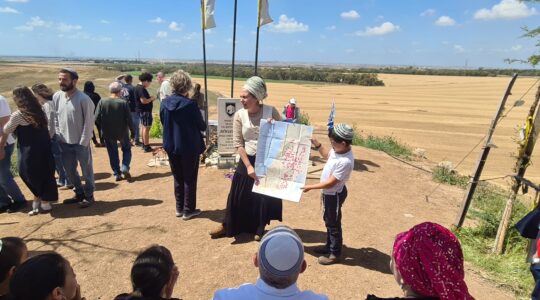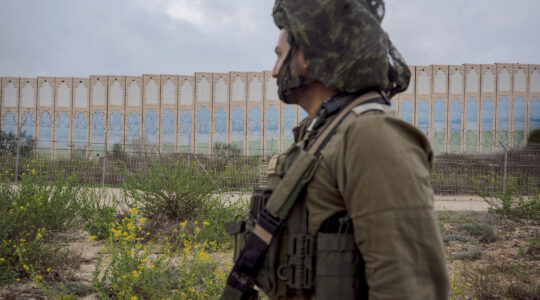NAZARETH ILIT, Israel (JTA) – Saher and Fida Abudbai grew up and lived most of their lives in Nazareth, the largest Arab city in Israel.
Now they live in the hills above in what is considered a Jewish city, Nazareth Ilit.
They would have preferred to stay in Nazareth, near their families, friends and work. Its labyrinth of steep, winding streets is the cultural and political center of Arab life in Israel, and the city is still very much the heart of the Abudbais’ lives.
But like many young families, they simply could not afford to buy a home in Nazareth, which is running out of room to grow.
“It was a financial decision,” says Fida, 32, a social worker who still works in Nazareth and sends her two young daughters to school there. “An apartment of the same size in Nazareth costs twice as much as ours.” Gazing out from the balcony of their seventh-story apartment, she sounds resigned. “There’s just no land left for building,” she says.
Nazareth Ilit was built by the Israeli government in 1956 as the cornerstone of a strategic decision to Judaize the Galilee, a majority-Arab region of Israel. More than 50 years later, the Galilee remains mostly Arab, and contrary to the intentions of military planners who designed Nazareth Ilit, the city is losing its Jewish residents. Meanwhile, the city’s Arab population is growing – now 15 percent of the city’s 52,000 residents.
The evolution of Nazareth and Nazareth Ilit is part of the broader story of Israel’s uphill effort to boost the Galilee’s Jewish population. It also points to the growing phenomenon of Israeli Arabs moving into Jewish areas. Mostly educated and from the middle class, these Arabs are drawn by the higher quality of life and services in Jewish areas, in contrast to urban Arab communities that suffer from public neglect.
“When there are no plans made in Arab areas, people out of lack of choice have to go elsewhere,” says Cesar Yeudkin, an urban planner at Bimkom, an Israeli nonprofit organization that promotes the integration of human rights in urban planning.
The director of Israel’s Interior Ministry, Arieh Bar, says the government is not neglecting Arab communities. He says the government has approved zoning plans for thousands of new apartments in Nazareth over the past four years, and the ministry has worked to improve planning for Arab towns and villages.
“There has been great progress,” he says.
It remains to be seen whether these new plans can reverse decades of neglect.
In northern Israel, more and more Arabs are moving into towns established for Jewish residence, such as Carmel and Ma’alot, Yeudkin says. In central Israel, neighborhoods such as Jerusalem’s French Hill, also established for Jews, are experiencing the same phenomenon of Jewish attrition and Arab influx.
In Nazareth Ilit, the phenomenon owes to the circumstances of its birth, which saw the state expropriate some 300 acres of land, much of it from landowners in Nazareth and surrounding villages, to create the new city. The move led to a shortage of land for the rapidly growing local Arab population.
These days in northern Israel, many Jewish Israelis, particularly younger ones, leave home for the center of the country, where the vast majority of Israelis live and where jobs are more plentiful. This includes tens of thousands of immigrants from the former Soviet Union who were settled in northern Israel in the 1990s. In Nazareth Ilit, Russian-speaking Israelis comprise 60 percent of the city’s population, though their number is dwindling.
With municipal elections for Nazareth Ilit – and cities across the country – scheduled for Nov. 11, a new list of Arab candidates hopes to capitalize on the votes of the city’s growing number of Arab residents.
“Nazareth Ilit is already a mixed Arab-Jewish city and no longer a Jewish city,” says Salim Khoury, a former city council member who again is running for office. He wants to establish Arabic-speaking schools so local Arab residents will feel more connected here.
Relations between the city’s Jewish and Arab residents are mostly smooth, although some Jewish residents have resisted selling apartments to Arabs.
Dan Rabinowitz, an anthropologist at Tel Aviv University, moved to Nazareth Elit for a year to observe the changes here for his book, “Overlooking Nazareth.” He says he was taken aback by how threatened some of the city’s Jewish residents felt by the notion of Arab neighbors.
“It made even the most liberal, secular, modernized Israelis into something that is much more extreme, exclusive and generally intolerant,” he says.
On the streets of Nazareth Ilit, Jewish residents expressed a range of viewpoints.
“I have an Arab neighbor across the hall and I have no problems with her,” says a woman who asked that her name be withheld. “But I would prefer they stay where they came from. It’s better if each group lives separately.”
Eliezer Gershoni, 86, who has lived in the city since 1965, is about to sell his house on Zippori Street. Most of the small houses on the street with private gardens, like his, have been sold to Arab families. He says it will be hard to find a Jewish buyer.
Gershoni faults the government for not investing more in the Galilee, both in Arab and Jewish communities. He says the government should have been investing in Israel proper rather than diverting resources to Jewish settlements in the West Bank.
Geremy Forman, who teaches and researches the historical, legal, and geographical dimensions of the Israeli land regime at Tel Aviv University and the University of Haifa, says he is troubled by the Israeli paradigm of Arabs and Jews living separately.
“I think it is mistaken to see continued ethno-national segregation as a solution to the difficulties surrounding Jewish-Arab relations in Israel,” Forman says. “In my mind, residential segregation has always been part of the problem. It perpetuates stereotypes, prevents real understanding, and facilitates discriminatory government and Jewish Agency policies that make genuine Jewish-Arab rapprochement in the country difficult to imagine.”
Even when Jews and Arabs do live together in cities like Nazareth Ilit, there is little mixing between the groups.
“For the Arabs here the city is like a hotel, a place they sleep, but their daily life is not here,” says Orna Joseph, the municipality’s spokeswoman.
“On some level it is an example of coexistence, but there is a lot of suspicion even though I would like to say everything is ideal,” she says. “There is a fear that their 15 percent could turn into 20, 30, even 50 percent, God forbid, and that then they’d take over.”
The Abdubais hardly view their family’s decision to live in a pleasant, affordable neighborhood as part of any plan to “take over.” But they do worry that their generally good relations with their Jewish neighbors, who constitute about half the population of their “mixed” building, could sour during times of heightened political tension.
“There are outbursts here and there,” Saher says. “But what will happen during times when we are really in different camps?”
JTA has documented Jewish history in real-time for over a century. Keep our journalism strong by joining us in supporting independent, award-winning reporting.





